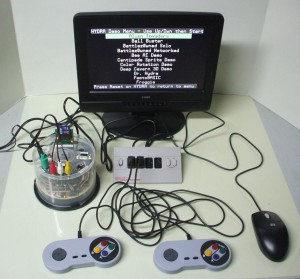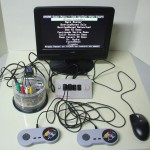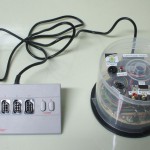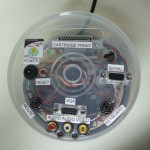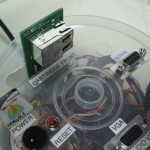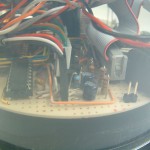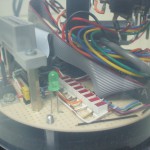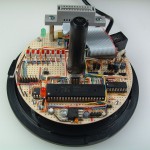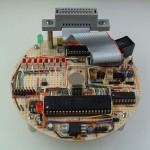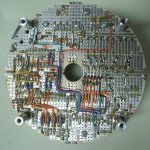Hydra retro game console clone
Scratch built Hydra game system clone in a CD Spindle case – Full Featured
Here is a project that I hope you find interesting. This is a fully functional Hydra game system clone built within a CD Spindle case. It has made appearances at UPENE and similar shows and I expect to bring it to future events. The Hydra Schematics and code are in the Hydra book so I will just focus on the construction details here. During the construction several recycled parts were used to help reduce the cost of the project.
This originally started out as a Propeller DEMO board that I built in a CD Spindle case as I was learning more about the Parallax Propeller processor. I bought the Hydra Book and CD which was a more advanced implementation using the Propeller chip to implement a retro game console. There was a lot of interest in the Hydra at the time. Since you could only buy a Hydra console as the whole set with another book I decided to rebuild the DEMO board project and instead make it a complete Hydra system within a CD case. There was a lot to pack in there since I wanted to use all the features and have a nice finished look when it was done. The only differences between a real Hydra and this clone is that I left off the 4-pin USB2SER port and used a MAX3232 in place of the on-board FTDI USB adapter for programming. Other than that all the features are present:
- VGA port
- Composite video port
- Audio port
- Mouse port
- Keyboard port
- Reset Button
- Cartridge adapter
- Debugging LED
- Power LED’s
- Cartridge LED
- 8 LED’s on VGA port
- Tri-State buffer w/jumper on VGA port
- Hydra NET port
- Serial Programming port (instead of USB)
- Two NES ports for Gamepads, etc
- On board 5V and 3.3V regulators
- Connector for external wall wart PS
The entire project is housed within a standard 50 CD/DVD Spindle case. This gives the completed game system a nice finished look and the status LED’s are visible through the case.
It is tightly packed in the case but everything fits! One reason is the use of the CD PCB that I made for the SpindleBot robots. These protoboards let me use all the available space to install components. It has parts and wiring on both sides of the board. To make the project work one of the main features needed was the cartridge port. I didn’t want to use a standard PCB mount 20-pin edge card connector since that would be too low in the case and I’d never be able to insert or remove the cartridges with the case on. The solution ended up being an easy one. I found a 20-pin edge card connector for ribbon cable with mounting ears. These connectors were ones that I had used in other projects and thought they would apply here. With a couple of metal standoff’s to raise it up the connector is at an ideal height to allow the cartridges to be used with the cover in place. A short ribbon cable connects this to the main board.
When I built this clone game system the NES connectors were hard to come by. At first I was going to buy some NES extension cables then cut off and end to attach to the main board. Instead I came across an NES option called the FOUR SCORE (NES-034A) which has the NES connectors mounted in a nice case and adds a TURBO feature. I just cut the end off that and then installed a new .100″ connector so I can plug it onto the bottom of the PCB. One little notch in the back of the cover gives room for the cable to pass through.
In regards to “re-cycled” parts there is the CD/DVD spindle case, power connector, Wall Wart power supply, Audio/Video RCA plugs (salvaged from a dead piece of video gear being scrapped, VGA Status LED’s (from an old HVAC control board), VGA connector and ribbon cable, Misc caps, and most of the wiring. Even the solid cable used as the wiring for the board was recycled solid copper wiring from the installation of a new PBX. When I build one off and odd projects like this I try to use what I have on hand.
I eventually picked up a used Hydra board so now I have a real one to compare it to. Now with two working systems I can experiment with the Hydra NET and some other features.
Pictures of the finished project are shown below.
- Retro Hydra game console clone in CD spindle case
- Hydra clone – Gamepad connectors
- Hydra clone – Top of console
- Hydra clone – Cartridge slot
- Hydra clone wiring
- Hydra clone LED’s
- Hydra clone base
- Hydra clone – Top of board
- Hydra clone – Bottom of board
